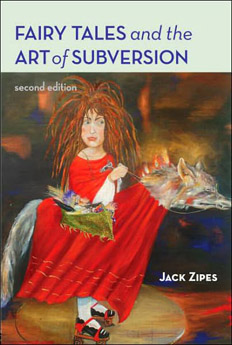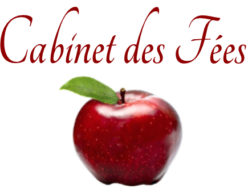Fairy Tales and the Art of Subversion
by Jack Zipes, Routledge, 1985
Reviewed by B. Haro
 Fairy tales — whimsical stories for youth, timelessly heralded for their universal truths and innocuous beauty… or maladjusted tools of the power elite for compulsory indoctrination of children to socialized norms? The answer, rather complicated and frighteningly situated with the latter, forms the analysis of Jack Zipes’ Fairy Tales And The Art Of Subversion.
Fairy tales — whimsical stories for youth, timelessly heralded for their universal truths and innocuous beauty… or maladjusted tools of the power elite for compulsory indoctrination of children to socialized norms? The answer, rather complicated and frighteningly situated with the latter, forms the analysis of Jack Zipes’ Fairy Tales And The Art Of Subversion.
After rummaging through the very large, very dense closet of fairy tale discourse, Zipes recognizes that everyone seems to overlook or neglect to mention the rancid skeleton slumped in the back corner. The book’s modest conceit is to briefly discuss that skeleton (henceforth posited as the sordid social history of fairy tales), which is centuries old and has been busy fouling up the closet’s goods. Zipes makes no claim to reconstruct a complete mold of the skeleton’s former features, but he damn well sketches a convincing likeness.
The seven chapters contriving this social history of fairy tales are as follows:
1) a brief justification of the book as a gap-filler to the overall discourse of the genre;
2) an examination of Charles Perrault’s contribution to the establishment of the classical fairy tale during the 18th century, sociopolitically interpreted as the oral tradition of folk tales co-opted and disfigured alongside the maleficient rise of the bourgeois during which the feudal era ended and children came to be viewed less as critters and more as proto-humans to be embellished with civilizing norms and women spectacularly feared;
3) in which fairy tales leapfrog to Germany, where the Brothers Grimm (both consciously and otherwise) further catalyze the bourgeois conglomerate taking hold in Europe, in their cataloguing, stylizing and revising already-sanitized versions of tales from numerous sources;
4) which then find a friend in Hans Christian Andersen over in Denmark, characterized as a tragic figure who utilized the genre as a platform for agonizing over the difficulty of reconciling individualistic aspirations empowered through gifts of providence and 19th century essentialist biology, with the increasingly difficult task of being accepted by the status quo who aren’t apt to accept you anyhow;
5) and by this point in history, a few writers (George MacDonald in Great Britain, Oscar Wilde in Ireland, L. Frank Baum in America) not only begin to question the relationship of fairy tales to the institutionalization and maintenance of dominion by the ruling classes over everybody else, they also begin to poke teeny tiny holes into the genre and thus, its social directives) through subverting its forms, to relative success;
6) but whose failures at significantly altering the fundamental paradigm of a centuries-in-the-making civilizing (yet dehumanizing) process allow for an incredibly dense, difficult glimpse into the extreme effects of fairy tales gone horribly, horribly awry — the shift from the Weimar Republic to the Third Reich of Nazi Germany — followed in close second by the adorable machinations of Walt Disney;
7) and finally, exiting that somber journey we move into a decades-long post-war landscape where more and more authors begin to question what the hell went wrong with western civilization, how fairy tales contributed and how we can possibly pervert their original intent so they no longer suffice as antiquated tools of enforced submission for the minds of children and adults alike.
This then, is the general scope of the book. In each chapter, Zipes of course more fully fleshes out the autobiographies of the authors who have come to be considered classical models of the fairy tale genre, althewhile casting them as corollary agents to the larger task proceeding pell-mell throughout centuries and continents — that of one social class subjugating the rest as best it can, in as many ways as it can. For each author, he selects several of their more popular and enduring works in order to discuss the methods in which the tales conform to or reject the regulating biases of inner/outer life for children as they find their way in the world, and for adults as they contend with a society that doesn’t seem fit or just in its relation to individual happiness. Zipes accomplishes this task of illuminating the historical trajectory of the fairy tale with considerable zest; he compacts a considerable amount of information and meditation into a slim volume. The book accomplishes what all great books do (for me, at least) — cultivate the gluttony of raiding his bibliography for more to read, simply because he poses so many tantalizing questions and the answers (so suggestive!) cannot be provided by this text alone.
Jack Zipes’ Fairy Tales And The Art Of Subversion, first published when I was four and being exposed to the literary genre in question, is one of the more maddening books I will probably read as an adult. I suspect Zipes might even derive a perverse pleasure in this prospect. Similar to the minority of innovative, progressive stories which he lauds for their democratically liberating potential, his historical interrogation of the fairy tale in the civilizing process of children engenders a disquieting urgency to reinterpret their effects on my own childhood. Which, even if I were in the privileged position to recollect those formative years, would still leave me with the nagging sense that those effects have long aggregated into a (to borrow the terms) “psychogenetic” sediment beyond the pale of any capacity to alter the “sociogenetic” conditions of my life or those around me. Or have they? I suppose this is ultimately the question, for another characteristic Zipes’ prose shares with the subversive forms (as instigated by MacDonald, Wilde, Baum and receiving their due treatment from a greater multiplicity of contemporary authors) is upholding the tension of ambiguous endings and unresolved conflicts. This means, simply, that the struggle for a better life as exemplified by our most progressive fairy tales will never really end, and in that struggle there is a utopian ideal that might be achieved. But if history is any indicator, probably not, in which case I’m headed to the library to hang out with Dorothy in Oz.

